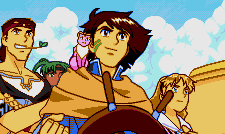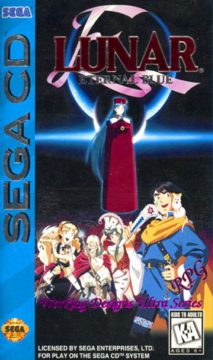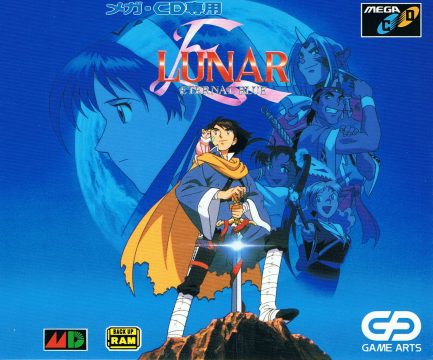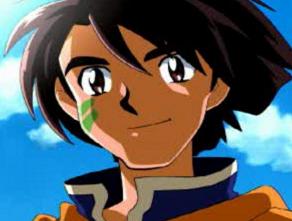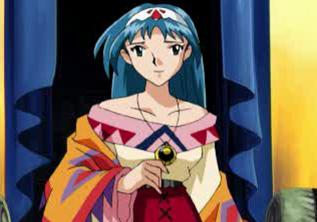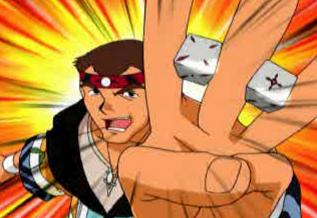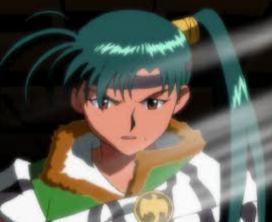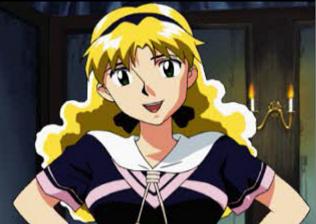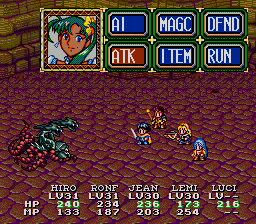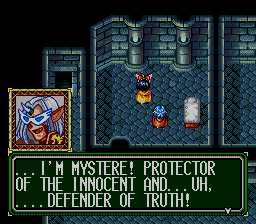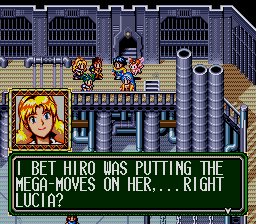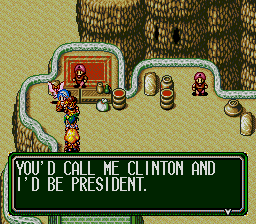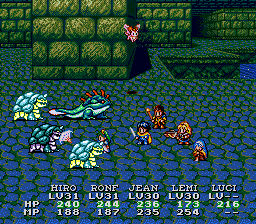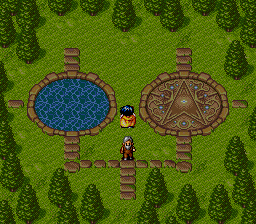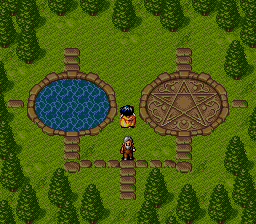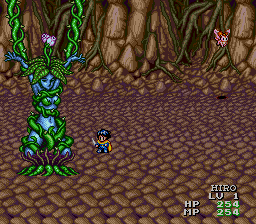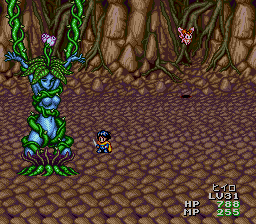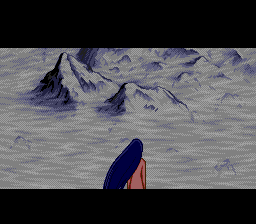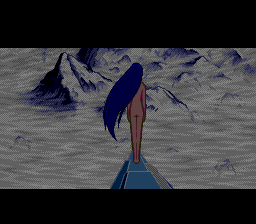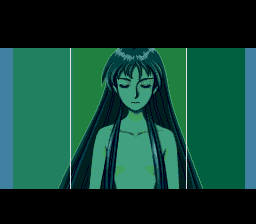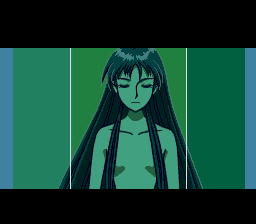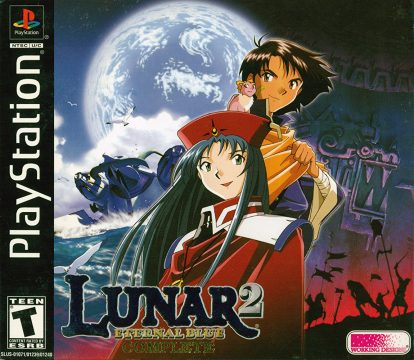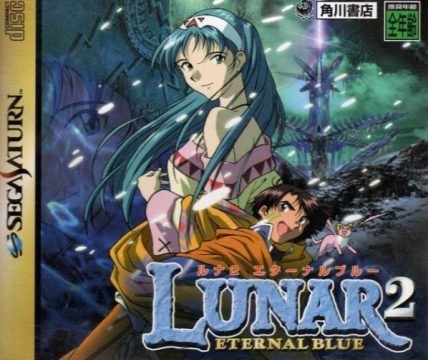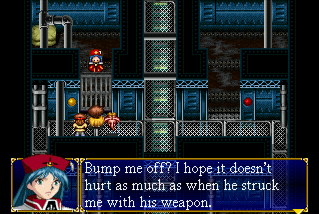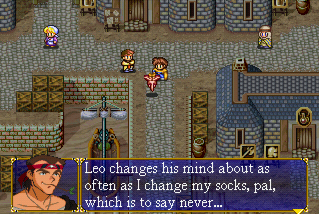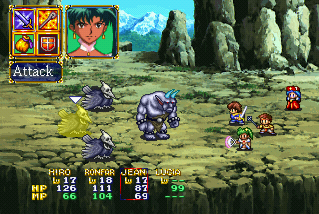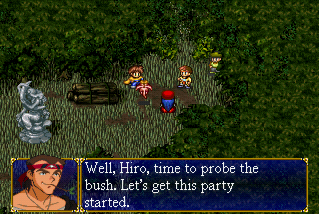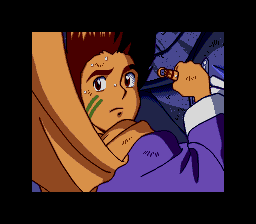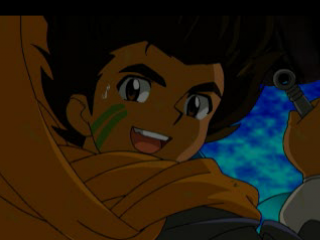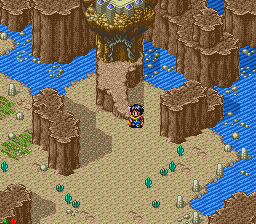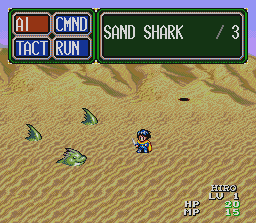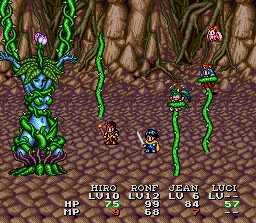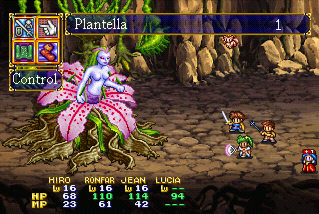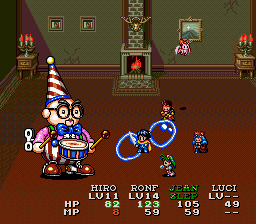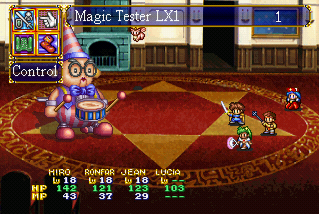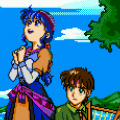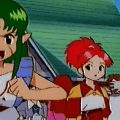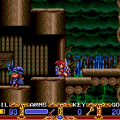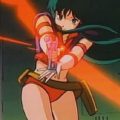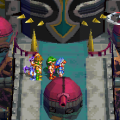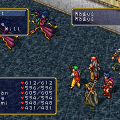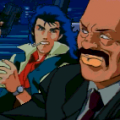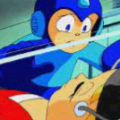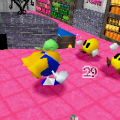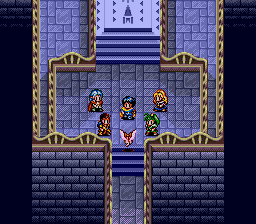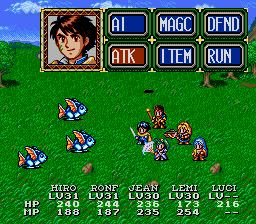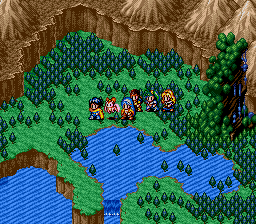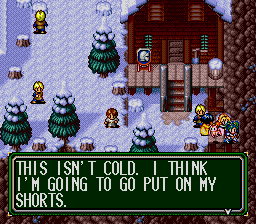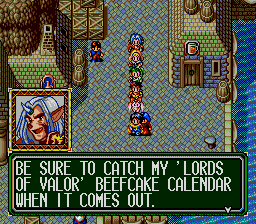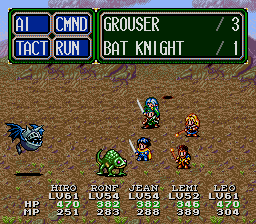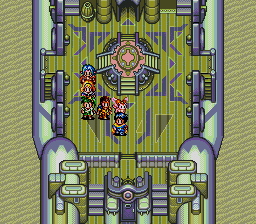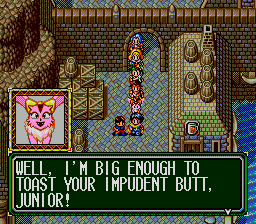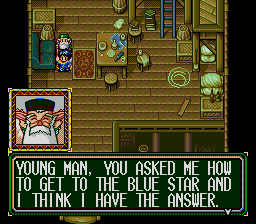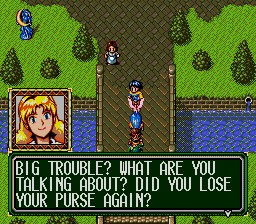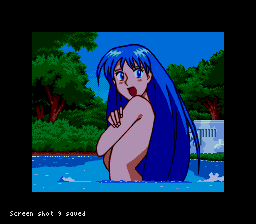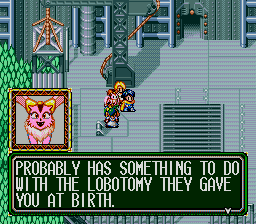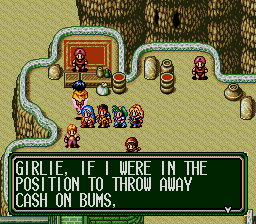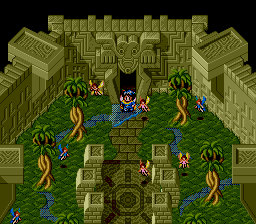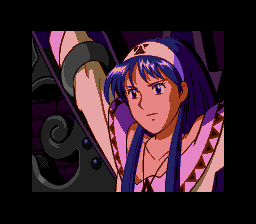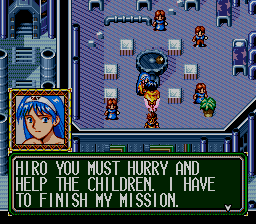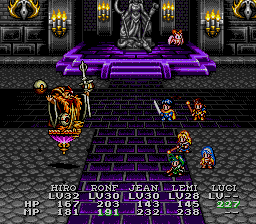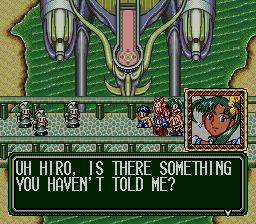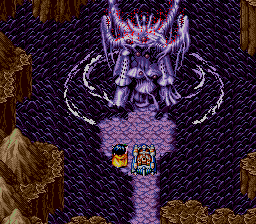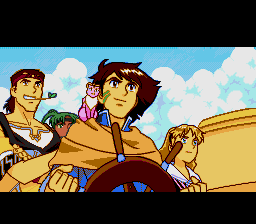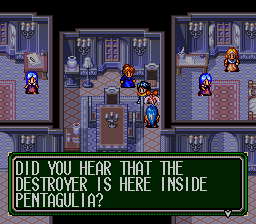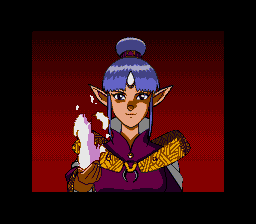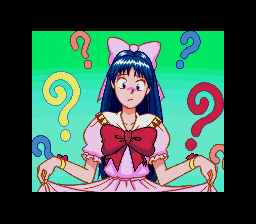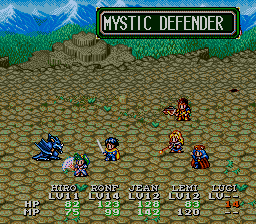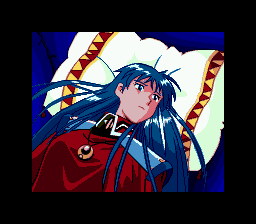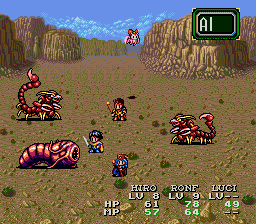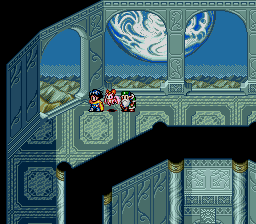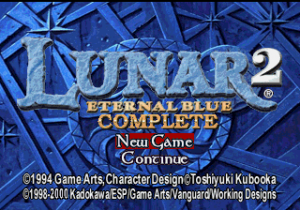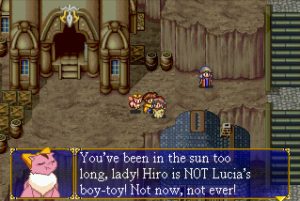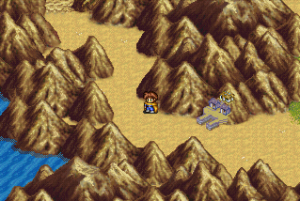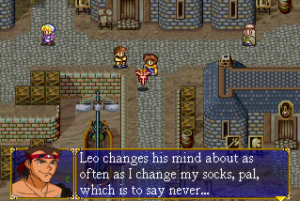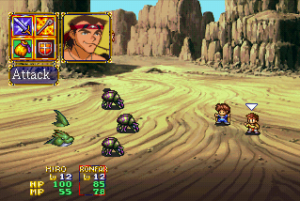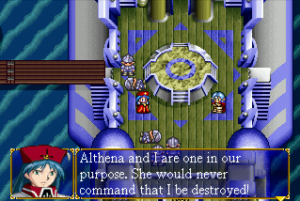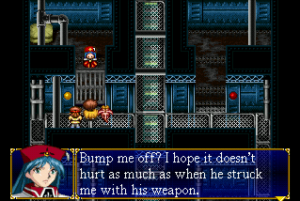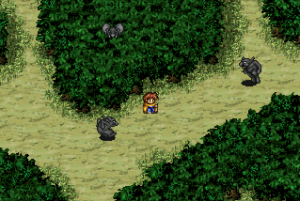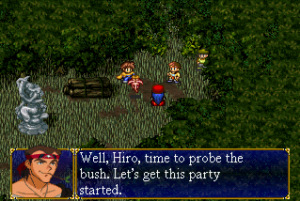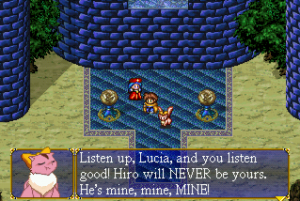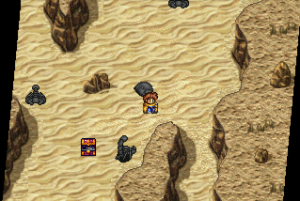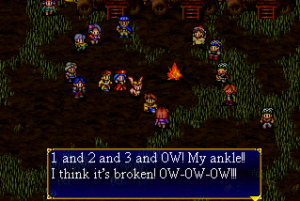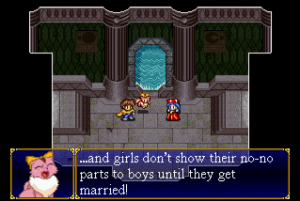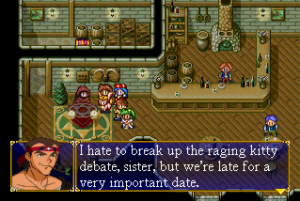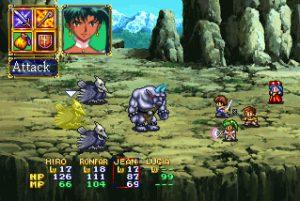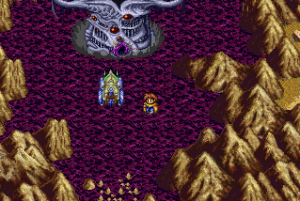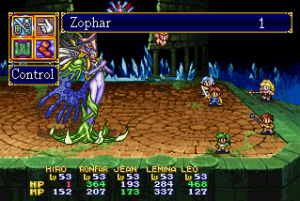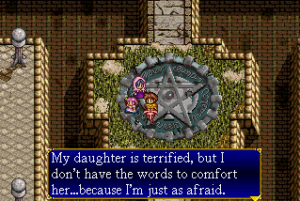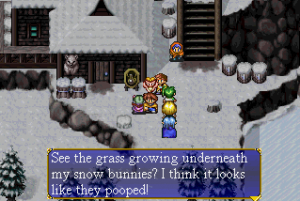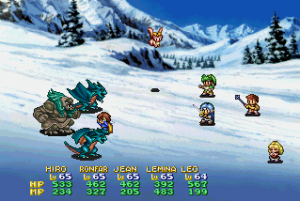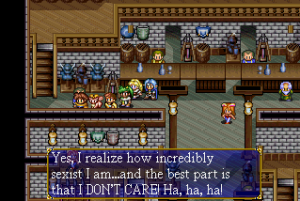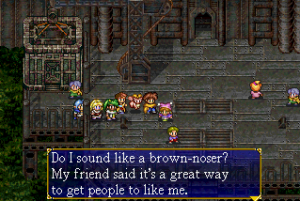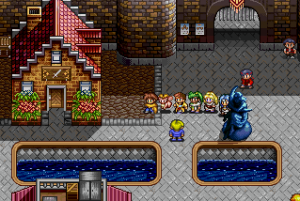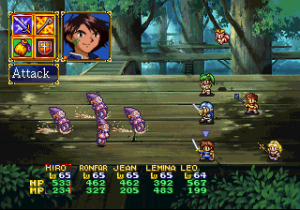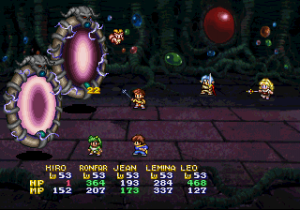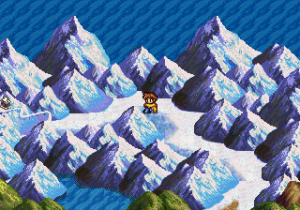- Lunar: The Silver Star
- Lunar: Eternal Blue
- Magical School Lunar
- Lunar: Dragon Song
Lunar: Eternal Blue takes place 1000 years after the original, after most of the original heroes have long passed on. The story this time focuses on young Hiro, an archaeologist fascinated with the stories of ages past. During an expedition, he sees an odd flash at a nearby tower; upon investigating, he meets a rather strange woman named Lucia, who wears an odd red outfit and demands to speak with Althena. There is great danger for the world of Lunar, she explains, which is made evident when a cruel voice that calls itself Zophar nearly crushes her to death and cripples her severely. After resuscitating her, Hiro and Lucia venture to the holy city of Pentagulia in search of the Goddess.
Things aren’t so simple though, as the party is stalked by Leo, the Holy White Knight who devotes his whole life to Althena and pilots a gigantic vessel called the Dragonship Destiny. He’s convinced that Lucia is the “Destroyer”, a being sent from another planet to bring darkness to Lunar, so she must be destroyed. Of course, he’s quite mistaken, and the plot thickens when the gang learns that there’s something amiss with the Althena currently ruling the world.
Characters
Hiro
A treasure hunter who lives with his adoptive grandfather Gwyn. He stumbles onto Lucia, immediately falls for her, and vows to help her in her journey. Attacks with boomerangs.
Ruby
A tiny flying dragon similar to Nall, though she’s a red dragon, and is actually aware of her species (no one in the story actually believes her, though in a case of dramatic irony, anyone who’s played the first Lunar knows she’s probably correct). She’s Hiro’s best friend, and also takes on part of Luna’s old role in that she’s insanely jealous of Hiro and takes great offense of his attraction to Lucia. She’ll also deliver small attacks in combat that can help wipe out enemies that are near death.
Lucia
A mysterious blue haired woman who hails from the Blue Star, and must find Althena at all costs. While outwardly human, she understands little of their emotions due to her solitary existence.
Ronfar
A disgraced ex-priest, who has since taken up drinking and gambling. He used to be involved with Leo’s sister, Mauri, until Ronfar tried to cure her of sickness and instead unknowingly turned her evil.
Jean
Jean was raised as an assassin for the Blue Dragon Cult, though eventually escaped and put her martial artists training to use as a dancer for a traveling caravan. In spite of her cheerful demeanor, she still has flashbacks to her haunted past.
Lemina
The descendent of the Ausa clan (Lemina and Mia) from the first game, Lemina couldn’t be farther removed from their shy, quiet dignity, instead using her magic powers for money grubbing purposes, all in hopes of resurrecting the fallen city of Vane.
Leo
A zealous knight of the goddess Althena, he is initially an antagonist, on the hunt for the mysterious blue haired girl his superiors have informed him of. He eventually realizes the error of his ways and helps the team, though initially does so under the guise of “Mystere”, a masked superhero who is hilariously oblivious to its transparency.
Eternal Blue improves on practically every facet of the original. The graphic style is similar, but makes better use of the Genesis’ limited palette, for a much richer looking game. There’s much more voice acting, and the cutscenes are not only more plentiful but far better animated. The story is more elaborate, and it’s a longer game too.
In spite of all of these improvements, the battle system remains mostly unchanged. The only major difference is the magic experience system, which grants you points separate from regular experience points, allowing you to improve your special attacks how you see fit. However, each character still has locked-down skills, so customization is still minimal. The difficulty level is also substantially higher than the original; some of the dungeons are long and brutal, and the battle against Borgan remains one of the most difficult in a 16-bit RPG. There are also added load times, a little disappointing considering how speedy the original was.
Of course, while the battle system is functional, the real heart of Lunar: Eternal Blue lies with the writing, just as it did in the original. Due to the time span, it’s otherwise not immediately clear how the two games connect. However, once Hiro builds up his party, then the links begin to unfold, as you explore the cities of Meribia and Vane, as well as the ruins of the Grindery. It’s fascinating to watch how these places have changed (or haven’t) in the intervening millennium, as the world deals with the consequences of the events of the first game.
As far as returning characters, Nall shows up in human form as the leader of a “Lost Boys”-type group of kids; he provides one of the sole links between the heroes of this game and the last one, even if his role is minor. Ghaleon also makes an appearance, though his surprise existence is not immediately clear, and he’s not really a villain this time around. Ramus’ distant offspring also makes an appearance, who not only looks but acts the exact same. Lemina is the descendant of Mia but acts nothing like her; meanwhile, Ruby is more or less exactly the same personality as Nall in the original. Ronfar, in a weird turn, is basically a variation of Kyle with Jessica’s abilities.
The strength of the game relies on the link between Hiro and Lucia. He accompanies her on this quest partially out of a desire for adventure, and partially due to her enchanting beauty. Their interaction is a huge contrast to the childhood buddies relationship of Alex and Luna since Lucia, technically, is not human. (Mild spoiler: she’s not Althena either.) She doesn’t understand the basics of social interaction, demonstrated in game by the fact that she attacks completely independently of the other party members. Outside of the player’s control, she typically hides around the battlefield, occasionally casting defensive magic on herself and only attacking enemies when directly threatened. She treats the player as she treats the party members; cold and distant. It’s only through the course of the game that she begins to understand humanity, that she begins to trust Hiro, and then she finally becomes a playable character. Even though Hiro is infatuated with Lucia from the moment he sees her, the actual romance blooms over the course of the story, which is much more interesting than the “childhood friend” designation of Luna that simply asked the player to fill in the emotional blanks.
As with the original Lunar, Eternal Blue‘s biggest strength comes with how its characters grow over the course of the game. What seem to be one-dimensional personality traits are broadened as each of them faces something of their past, all tightly wound in together with the narrative. Lots of RPGs have problems where characters join the party, have their story told, then are promptly forgotten, or have a backstory completely divorced from the core plot. Eternal Blue binds these things together far better than most other RPGs, especially of the era. As with Lucia, the evolution is also represented in gameplay, as characters change outfits and gain new abilities. The ending is positive, though bittersweet; however, if you pay attention to the menu, there’s an option for an “epilogue”, which lets you play a few more hours past the final boss to get the true best ending, which results in one of the most heartwarming finales of just about any 16-bit JRPG.
However, even though the plot is more elaborate, and the game is (generally) better scripted, it’s missing some of the charm of the original game. Part of it has to do with the tone – the original started as a naive adventure before morphing into a coming of age story. It got dark eventually, but there was still a lightheartedness about it. Eternal Blue starts off more morosely, and it stays that way throughout. There’s still quite a bit of the typical Working Designs humor to lighten things up, but in becoming a mature story, it’s also less careful and whimsical. The characters are also fun, but since their relationships lie outside of the core party members, it lacks some of the amusing inter-party banter and conflict of the original.
The writing is generally just as excellent as Working Designs’ other titles, though it does contain the infamous Bill Clinton joke, often referenced by detractors as an example of fourth wall breaking humor that just doesn’t fit. Combined with the innuendo in the dialogue and the naked Lucia in the opening cinema (albeit with detail-less features), it’s a wonder that the game received a K-A rating from the ESRB.
However, at this point, Working Designs was paranoid about the return policies of certain large retailers, and was increasing the difficulty levels to prevent players from beating them too quickly and then taking them back to the store. There were minor tweaks in the original Lunar, but nothing big; here, almost all of the enemies had their attack, defense, and HP increased, and many items are more expensive. None of this really makes the game more difficult – since the combat is fairly simple, all you do is pick the most effective attacks and balance them against your dwindling MP resources – so all it does it make it more tedious.
An even more pressing localization concern, though, is a “feature” added by Working Designs which charges magic experience points every time you save. The rationale behind this is because Lunar, unlike many other console JRPGs, doesn’t rely on save points, so you can save anywhere. By limiting the amount of times you can save, it increases the tension of having to replay parts of the game if you die. It doesn’t actually have the effect of limiting the player though, it feels more like they’re being penalized for performing a necessary game function. Furthermore it incentivizes grinding in order to regain any lost magic experience. Together with the bolstered stats, it makes an already difficult game even more frustrating.
A few visuals were tweaked for the American release too – though Lucia only had Barbie doll features in the Japanese intro, the curves were removed, and a few shots were changed to remove showing her behind. The usual topless female enemy sprites and pentagrams were changed too.
Localization Screenshot Comparisons
Lunar 2: Eternal Blue (ルナ2 エターナルブルー) / Lunar 2: Eternal Blue Complete – PlayStation, Saturn (1998)
As with its predecessor, Lunar 2 received a remake for 32-bit consoles. Compared to the revisions between The Silver Star and Silver Star Story, the changes to the 32-bit port of Eternal Blue aren’t nearly as drastic. As before, the graphics have been almost entirely redrawn, and the random battles have been removed in favor of visible enemies. The magic experience upgrade system has been dropped, as characters gain and upgrade skills with regular level ups. With this gone, the most annoying problem with Working Designs’ Sega CD version is no longer an issue. There are two equipment slots for crests, which allow a small level of character customization. The item management has been simplified so characters use things from a shared pool at all times, instead of having individual inventories.
The soundtrack is very similar, except it benefits from being played through the system’s sound chip rather than being low-quality streamed PCM. It doesn’t sound quite identical (and as with Silver Star Story, there are slight instrumentation differences between the Saturn and PS1 versions), but it’s definitely much cleaner. However, Working Designs had added a new song to the Sega CD version, the Star Dragon theme, which used near the end of the game, but this is absent from the PS1 version.
Again, all of the cutscenes are full-motion video. The number of scenes actually had to be cut back, so a few scenes that were originally animated cutscenes are now done in the in-game engine. The FMV scenes that are present are generally longer than they were before, but they appear somewhat low budget, with some iffy animation and occasionally odd-looking characters. The opening scene has been changed a little to cover up Lucia’s body, and unfortunately also removed the extremely cool animation of the hands tearing apart the planet of Lunar and reducing it to a bloody mess. There’s no MPEG release of the Saturn version, which is two discs, so the cutscene quality is reduced in this version. The PS1 version is three discs and has the best looking video.
As with before, the dungeons have been completely redesigned, but this they’re much, much shorter and less intricate than the Sega CD’s. Occasionally they feel a little too straightforward – many areas that were previously hugely expansive mazes have been reduced to a single map. But at the same time, many of them were so gigantic that they became exhausting, so this cutback isn’t necessarily bad. Working Designs didn’t futz with the stats as they did in the Sega CD version, so it’s not nearly as hard either.
Additionally, some other battles, like many in the Vane Trial caves, are gone. The two battles against the Phantom Sentry have been removed with the second one replaced with a new dragon boss. There are two added dungeons in the Saturn version, and two more to the PS1 version. Bromides have been added, with extra ones appearing in the PS1 game. The requirements for getting some of them have been made more difficult in the North American version.
The storyline is mostly the same, to the point where much of the script and voicework is reused from the Sega CD game. However, there are still numerous small changes throughout. Jean is a little more angsty about her past, with some extra flashbacks. There’s an added scene at the caravan where Lucia walks in a bathing Hiro and doesn’t understand the breaking of social conventions. There are a few scenes where Lucia sings to calm down some crying infants. The name of the Blue Dragon Cult has been changed to the Shadow Dragon Cult, to make it slightly more subtle. There’s an extra scene where Lemina attempts (and fails) to use a flying carpet. There’s a scene late in the Sega CD version where an enemy encases Hiro in crystal, and the party rally around Lucia to convince her to free him. In the 32-bit versions, she just blocks the attack before it even reaches Hiro. None of these scenes are major, but they help flesh out the characters in small ways. A few other things have changed though, as Zophar’s uncloaked form at the end is different.
Like Lunar: Silver Star Story Complete, the PS1 version of Eternal Blue Complete came in elaborate packaging, containing the game discs, another making-of documentary, a soundtrack (consisting of very poor renditions of selected pieces of music from the game), a hardboard manual, a cloth map, a replica of Lucia’s pendant, and little cardboard standees of the main characters.
In the case of the first Lunar, the differences between the original and the remakes were so huge that it was impossible to deem one the definitive version. For Lunar: Eternal Blue, the Sega CD version is preferable for those who like longer, more brutal dungeons (and don’t mind the added difficulty from the localization) but for those who’d rather play for the story, the 32-bit version is the way to go, in spite of the minor story cuts/changes..
Screenshot Comparisons
Links:
